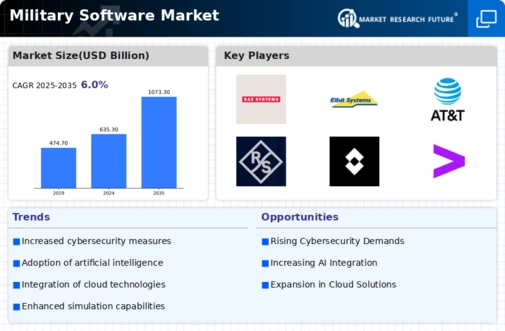Cybersecurity Concerns
As military operations increasingly rely on digital systems, cybersecurity has emerged as a critical concern within the Global Military Software Market Industry. Cyber threats pose significant risks to national security, prompting military organizations to invest in robust cybersecurity software solutions. This includes advanced threat detection systems and secure communication platforms. The growing awareness of potential vulnerabilities has led to increased funding for cybersecurity initiatives, thereby driving demand for specialized military software. The emphasis on safeguarding sensitive data and infrastructure is likely to propel market growth, as defense agencies prioritize cybersecurity in their strategic planning.
Increased Defense Budgets
Global military expenditure continues to rise, driven by geopolitical tensions and the need for enhanced national security. Countries are allocating larger portions of their budgets to defense, which directly impacts the Global Military Software Market Industry. For example, nations such as the United States and China are investing heavily in modernizing their military capabilities, including software systems for logistics, command and control, and cybersecurity. This trend is expected to sustain the market's growth trajectory, with projections indicating a market size of 1073.3 USD Billion by 2035, reflecting a compound annual growth rate of 4.88% from 2025 to 2035.
Market Growth Projections
The Global Military Software Market Industry is projected to experience substantial growth over the next decade. With a market size of 635.3 USD Billion in 2024, it is anticipated to reach 1073.3 USD Billion by 2035. This growth trajectory reflects a compound annual growth rate of 4.88% from 2025 to 2035. The increasing demand for advanced software solutions across various military applications, including logistics, command and control, and cybersecurity, is a key driver of this expansion. As nations prioritize modernization and technological integration, the military software sector is poised for significant advancements and investments.
Technological Advancements
The Global Military Software Market Industry is experiencing rapid technological advancements, particularly in artificial intelligence and machine learning. These innovations enhance decision-making processes and operational efficiency. For instance, AI-driven analytics are utilized for predictive maintenance of military equipment, reducing downtime and costs. The integration of advanced simulation software for training purposes also improves readiness and effectiveness. As military forces worldwide adopt these technologies, the market is projected to grow significantly, with a valuation of 635.3 USD Billion in 2024, indicating a strong demand for sophisticated military software solutions.
Integration of Simulation Technologies
The integration of simulation technologies into military training programs is transforming the Global Military Software Market Industry. Virtual and augmented reality applications provide immersive training experiences, allowing personnel to engage in realistic scenarios without the associated risks. This shift not only enhances training effectiveness but also reduces costs related to traditional training methods. Military organizations are increasingly adopting these technologies to improve readiness and operational capabilities. As a result, the demand for simulation software is expected to rise, contributing to the overall growth of the market as military forces seek innovative solutions to enhance their training methodologies.
International Collaboration and Joint Operations
International collaboration among military forces is becoming more prevalent, influencing the Global Military Software Market Industry. Joint operations require interoperable software systems that facilitate communication and coordination among allied forces. This trend is evident in multinational exercises and peacekeeping missions, where seamless integration of software solutions is crucial for mission success. As countries engage in collaborative defense initiatives, the demand for compatible military software is likely to increase. This collaborative approach not only enhances operational effectiveness but also drives innovation in software development, further propelling market growth.

















